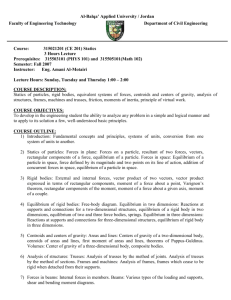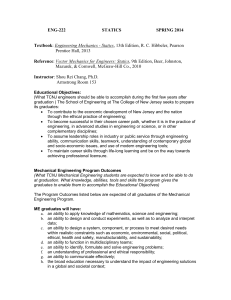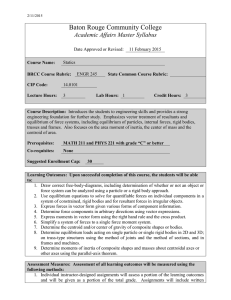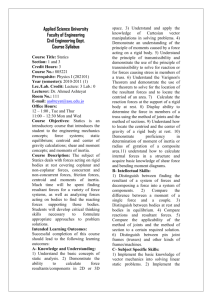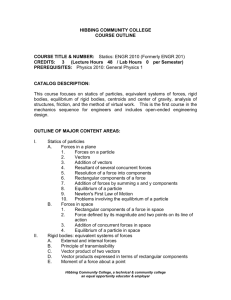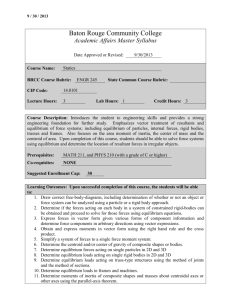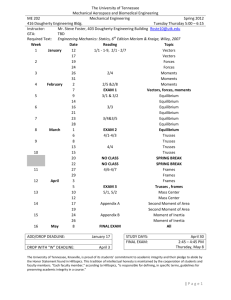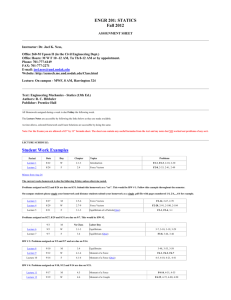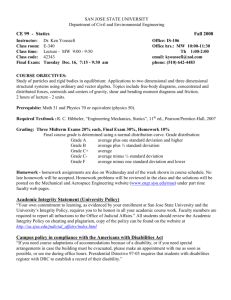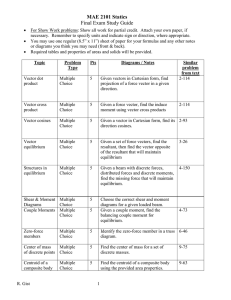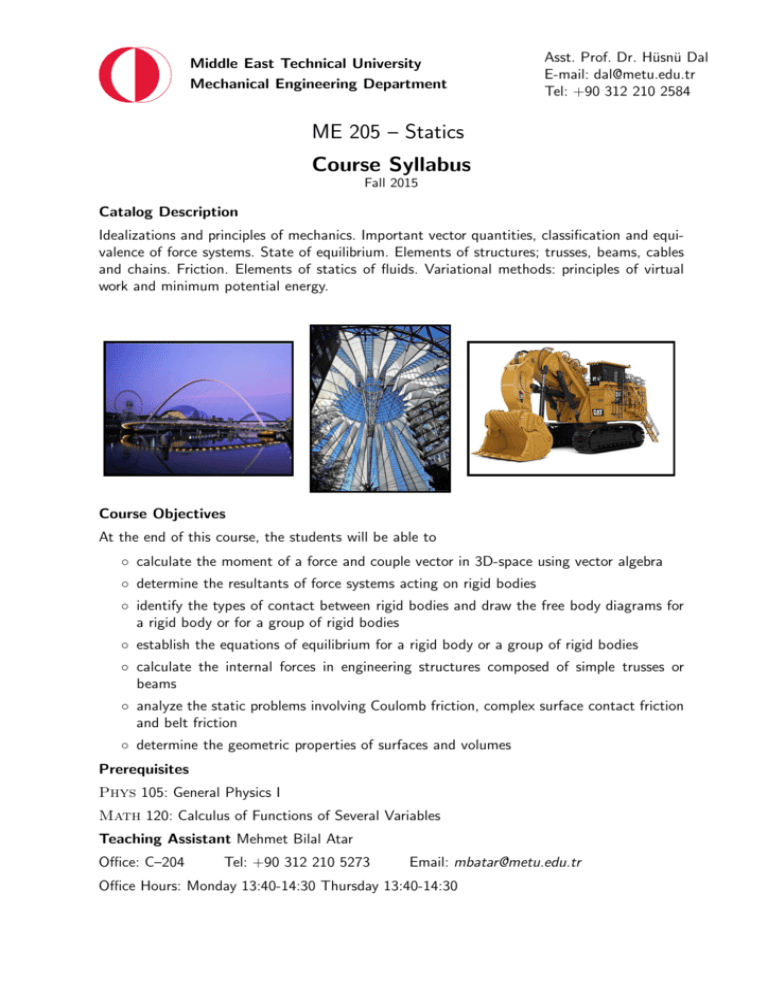
Middle East Technical University
Mechanical Engineering Department
Asst. Prof. Dr. Hüsnü Dal
E-mail: dal@metu.edu.tr
Tel: +90 312 210 2584
ME 205 – Statics
Course Syllabus
Fall 2015
Catalog Description
Idealizations and principles of mechanics. Important vector quantities, classification and equivalence of force systems. State of equilibrium. Elements of structures; trusses, beams, cables
and chains. Friction. Elements of statics of fluids. Variational methods: principles of virtual
work and minimum potential energy.
Course Objectives
At the end of this course, the students will be able to
◦ calculate the moment of a force and couple vector in 3D-space using vector algebra
◦ determine the resultants of force systems acting on rigid bodies
◦ identify the types of contact between rigid bodies and draw the free body diagrams for
a rigid body or for a group of rigid bodies
◦ establish the equations of equilibrium for a rigid body or a group of rigid bodies
◦ calculate the internal forces in engineering structures composed of simple trusses or
beams
◦ analyze the static problems involving Coulomb friction, complex surface contact friction
and belt friction
◦ determine the geometric properties of surfaces and volumes
Prerequisites
Phys 105: General Physics I
Math 120: Calculus of Functions of Several Variables
Teaching Assistant Mehmet Bilal Atar
Office: C–204
Tel: +90 312 210 5273
Email: mbatar@metu.edu.tr
Office Hours: Monday 13:40-14:30 Thursday 13:40-14:30
Course Content
I General Principles (1 week)
1.1
1.2
1.3
1.4
1.5
1.6
Mechanics
Fundamental Concepts
Units of Measurement
The International System of Units
Numerical Calculations
General Procedure for Analysis
II Force Vectors (1 week)
2.1
2.2
2.3
2.4
2.5
2.6
2.7
2.8
2.9
Scalars and Vectors
Vector Operations
Vector Addition of Forces
Addition of a System of Coplanar Forces
Cartesian Vectors
Addition of Cartesian Vectors
Position Vectors
Force Vector Directed Along a Line
Dot Product
III Equilibrium of a Particle (1 week)
3.1
3.2
3.3
3.4
Condition for the Equilibrium of a Particle
The Free-Body Diagram
Coplanar Force Systems
Three-Dimensional Force Systems
IV Force System Resultants (2 weeks)
4.1
4.2
4.3
4.4
4.5
4.6
4.7
4.8
4.9
Moment of a Force – Scalar Formulation
Cross Product
Moment of a Force–Vector Formulation
Principle of Moments
Moment of a Force about a Specified Axis
Moment of a Couple
Simplification of a Force and Couple System
Further Simplification of a Force and Couple System
Reduction of a Simple Distributed Loading
V Equilibrium of a Rigid Body(2 weeks)
5.1
5.2
5.3
5.4
Conditions for Rigid-Body Equilibrium
Free-Body Diagrams
Equations of Equilibrium
Two- and Three-Force Members
5.5 Free-Body Diagrams
5.6 Equations of Equilibrium
5.7 Constraints and Statical Determinacy
VI Structural Analysis(1 week)
6.1
6.2
6.3
6.4
6.5
6.6
Simple Trusses
The Method of Joints
Zero-Force Members
The Method of Sections
Space Trusses
Frames and Machines
VII Internal Forces(1 week)
7.1
7.2
7.3
7.4
Internal Loadings Developed in Structural Members
Shear and Moment Equations and Diagrams
Relations between Distributed Load, Shear, and Moment
Cables
VIII Friction(2 weeks)
8.1
8.2
8.3
8.4
8.5
8.6
8.7
8.8
Characteristics of Dry Friction
Problems Involving Dry Friction
Wedges
Frictional Forces on Screws
Frictional Forces on Flat Belts
Frictional Forces on Collar Bearings, Pivot Bearings, and Disks
Frictional Forces on Journal Bearings
Rolling Resistance
IX Center of Gravity and Centroid(1 week)
9.1
9.2
9.3
9.4
9.5
Center of Gravity, Center of Mass, and the Centroid of a Body
Composite Bodies
Theorems of Pappus and Guldinus
Resultant of a General Distributed Loading
Fluid Pressure
X Moments of Inertia(2 weeks)
10.1
10.2
10.3
10.4
10.5
10.6
10.7
Definition of Moments of Inertia for Areas
Parallel-Axis Theorem for an Area
Radius of Gyration of an Area
Moments of Inertia for Composite Areas
Product of Inertia for an Area
Moments of Inertia for an Area about Inclined Axes
Mohr’s Circle for Moments of Inertia
10.8 Mass Moment of Inertia
Grading Policy
Homeworks 10 %
Class Performance
5%
Midterms 50 %
Final Exam 35 %
Textbook
• Engineering Mechanics Statics, by Hibbeler, R.C., Pearson-Prentice Hall. (Latest ed.)
References
1 Beer, F.P., Johnston, E.R., “Vector Mechanics for Engineering Statics”, McGraw-Hill
International Book Company
2 Meriam,J.L., Kraige, L.G., “Engineering Mechanics, Statics”, John Wiley&Sons Inc.

